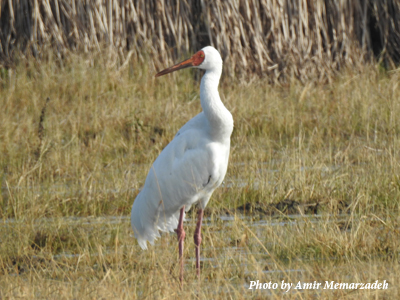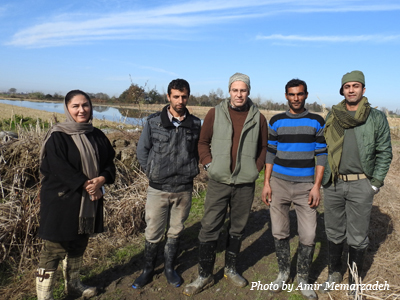For many years a single Siberian Crane has returned to its wintering grounds in Fereydunkenar, Iran, a small town near the Caspian Sea. The locals call him “Omid,” meaning “Hope” in Farsi. This lonely Siberian Crane has indeed become the symbol of hope for Fereydunkenar and its wetlands. The presence of the Siberian Crane each winter has helped protect habitat for millions of other migratory birds, while benefiting local rice farmers, who supplement their winter income with traditional duck trapping.

In 1998 a small crane conservation group, the Mazandaran Crane Conservation Association (MCCA), was formed in Iran with the support of Ellen Vuosalo Tavakoli (originally from Finland) and a few Iranian environmental conservationists. In 2000 this small group grew to include around 200 duck trappers, who joined MCCA by investing in local Trust Funds, which were intended to evolve into a loan program.
This was an important initiative for the conservation of Siberian Crane habitat in Iran, a project that was supported and co-funded by the Small Grants Program of the Global Environment Facility and the United Nations Development Program (2001-2004). As a result of this project and through MCCA’s efforts, local trappers became aware of the international importance of Siberian Cranes, and, most importantly, were recognized as “guardians of the cranes” by both Iran’s Department of the Environment and international organizations. Later, this area was listed as an “Indigenous Community Conserved Area” by the International Union for the Conservation of Nature.

After nearly 15 years local trappers still practice their traditional knowledge in preparing the wetlands and are still playing the role of Omid’s guardians – and that is why the lonely crane has returned for the past seven winters. The local trapper associations (now officially registered as local cooperatives) create a safe environment for the crane within their traditional damgahs, or duck-trapping blinds, which are designated No Shooting Areas and a Ramsar Site by the Department of Environment. These magnificent wetlands are in fact becoming one of the few remaining freshwater wetlands in Iran, and are one of the few options remaining in the area for wintering migratory birds in the face of rapid development and climate change.
On December 1, 2016 I was at the Fereydunkenar damgah, observing the lone Siberian Crane for about an hour. I heard his call three times….a call that is asking us to keep trying and to take all the necessary actions for the survival of his species. After all, his name is Hope, and we shall not give up hope!
Story submitted by Lisa Pourlak, environmental activist and PhD student at Tehran University, I.R. Iran, and member of the IUCN Crane Specialist Group.
